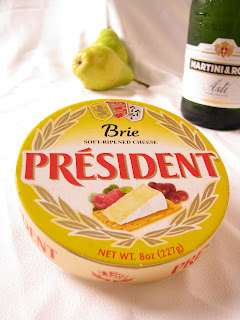I’m not French by the way. But this cheese is!
Brie is the most famous of all the French cheeses. I guess you could call it “The Queen of Cheeses”. Some people do anyway. The earliest known production of Brie was in the small French city of Brie in the year 774. During the French Revolution, Louis XVI last wish was supposedly for a final taste of Brie.
So what’s all the fuss about? What makes Brie so yummy? (Yes, it is funny to hear myself ask that question).
Brie is made from cow’s milk. About 6.60 gallons (that’s 25 liters) of pasteurized cow's milk are needed to make one Brie cheese. Pasteurized, of course, means the milk is heated to kill any bacteria contained in the milk. Brie is not pressed at anytime during the production. When cheese is pressed during production it squeezes out the watery liquid called whey. This results in a harder, firmer cheese.
So don’t squeeze Brie.
Brie doesn’t like that.
Brie’s a softie.
The Brie cheese I have chosen to review is President Brie. (Sings Hail to the Chief to myself).
Don’t be afraid my darlings! It’s edible!
BRIE'S NOTE: I thought the flavor of this rind was bitter so I would advise cutting it off before eating, unless you decide to bake it which in that case I would leave it on. The rind becomes milder during baking.
The rind protects the cheese while it is ripening. The affinage for Brie is 4 to 8 weeks. Affinage is a French word denoting the aging or ripening of cheese. Allowing the cheese to mature will develop its complex flavors.
Mmmm flavor. Where’s my knife?
Now let’s taste this baby! I’ve bought some crackers and some pears to accompany the Brie.
Of course I would never pair it with olives. Blech!
The best thing about Brie for me is that it is a perfect match with Champagne! I’m a total Champagne girl!
I chose Martini & Rosi Asti Spumante because it's my favorite. The bubbles of the champagne sort of cut through the rich creaminess of the cheese and totally enhances the flavor. It also pairs well with a red Bordeaux or Bourgogne (Burgundy).
The important thing to remember in a good pairing is that you’re able to taste both the cheese and the wine without one overpowering the other.
What we learned: Made from cows milk; soft cheese; mild creamy flavor; great with Champagne
Next time I’ll be sharing a recipe for Mushrooms Stuffed with Brie.
Hon hon hon! Se Magnifique! (Please read that with a French accent!)
P.S. My wonderful fiance took these great pictures for me! Thanks baby!








No comments:
Post a Comment